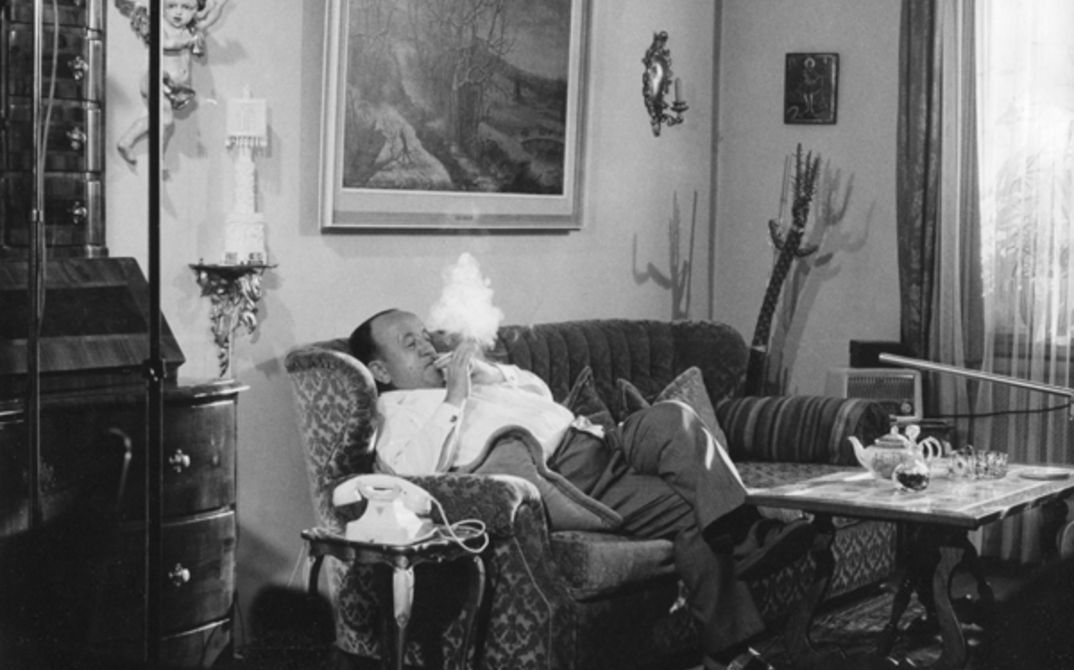The influence of Nekes’ experiments with form, as well as the ideas about education and self-awareness that he developed in Dörnberg, can be felt in Adolf Winkelmann’s first films, which made him a star of “Das andere Kino” at the Hamburg film festival of 1968. In ES SPRICHT: RUTH SCHMIDT (1968, 10.1.), his future mother-in-law talks about how she overcame her prejudices against him and art students in general. In ADOLF WINKELMANN, KASSEL, 9.12.1967, 11.54H (1968, 10.1.), he maneuvers through Kassel’s shopping district with a Bolex camera strapped to his body, filming himself and the attention he attracts.
Adolf Winkelmann’s brother Wilhelm and his friend Winfrid Parkinson sometimes joined the collective of four, which for a short time was made up of two married couples with a standard look, as did fellow students from the Kassel Werkkunstschule and the HbK. In 1969, its most productive year, the Dörnberg group presented nine films at the Oberhausen Short Film Festival, winning the main award for their half-hour HEINRICH VIEL (1969, 11.1.), a long fixed take of the assembly line at the VW plant in Baunatal. Winkelmann was accused of having made a fascist film with DIE FRESSE (1969, 11.1.). In his version of the Milgram experiment, there were real slaps instead of simulations of electric shocks. As a reaction to an article by the Dörnberg educational researcher Christian Rittelmeyer, who was skeptical of the social impact of Das andere Kino, WDR commissioned a three-part documentary about independent cinema in West Germany. DAS ANDERE KINO (1969, 12.1.) gives an excellent insight into the scene. It gave the Kassel filmmakers an opportunity to find their place in the conflict between aesthetes of form and political filmmakers. They directed their work towards the “target group concept” developed by the “Berlin” filmmakers who had been relegated by the DFFB, Harun Farocki, Hartmut Bitomsky and Günter Peter Straschek, all of whom were frequent guests at Dörnberg.
In the adaptation of the pulp novel VERTRAUENDE LIEBE – GLÜHENDER HASS (1969, 10.1.), in which Dörnberg staff play blue-blooded characters, the scenes were prepared and discussed with the help of the same video equipment that the DFFB students had used in Oberhausen to call for the end of individual filmmaking. For DER HÖCHERL (1969, 10.1.), which was a similar experiment to create a new world, the Kassel group paid a visit to the CSU politician Hermann Höcherl, a high-caliber figure of hate who turned out to be a very affable host.
The members of the collective parted ways at the end of 1969. Jutta Winkelmann and Gisela Büttenbender devoted their energies to setting up youth organizations of the KPD/ML in Berlin and Bochum, while Gerhard Büttenbender and Adolf made a clear move to agitation in their last works together. WORIN UNSERE STÄRKE BESTEHT (1971, 11.1.) documents a role-play that was supposed to trigger working-class consciousness in high-school students. With socialist realist pathos, STREIK BEI PIPER & SILZ (1972, 11.1.) depicts an episode from the time of the resistance to the occupation of the Ruhr and hyperinflation. Other filmmakers dubbed it “working-class Hollywood”. Gerhard Büttenbender lost his job at Dörnberg, while Adolf Winkelmann went from “target group work” to feature films.
At the first comprehensive Kassel Film Collective retrospective, which took place at the Kassel Dokfest recently and which Arsenal is repeating here, Winkelmann said: “At the time, to be attacked meant to be on the right path.” Thanks to the support of Kassel University, analogue prints have been digitalized, making the films more accessible again. (ph/th)
Some of the films will be screened in digital form, others as 16mm prints. Curated by Peter Hoffmann and Tobias Hering. Thanks to Jan Peters, Gerhard Wissner, Gerhard Büttenbender, Gisela Getty and Adolf Winkelmann. The screenings on 12.1. have been organized in conjunction with the Harun Farocki Institut.



